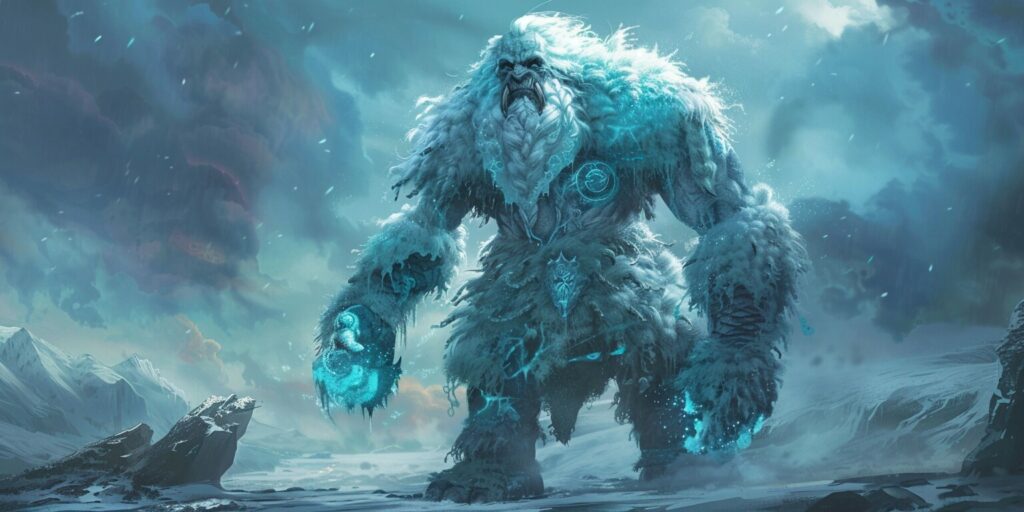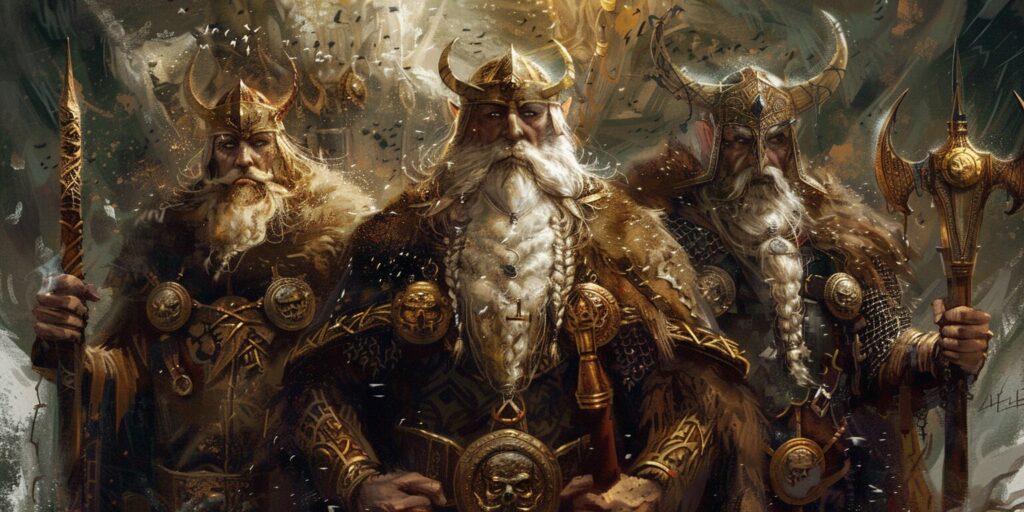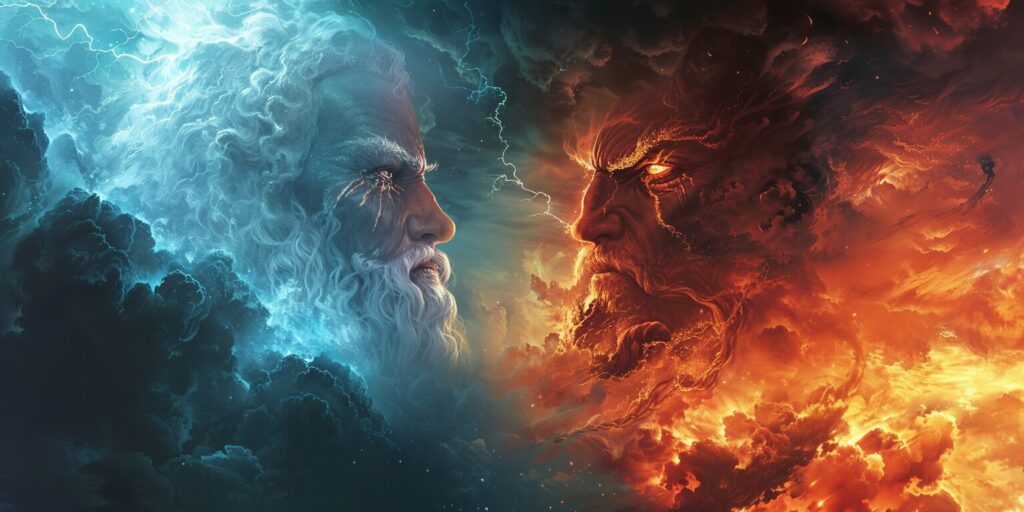Aesir Gods, Asgard, Ask and Embla, Midgard, Norse Gods, Norse Mythology, Odin, Vili and Ve, Ymir
In the Beginning: The Creation Story of Norse Mythology Unfolded
Norse mythology has intrigued people for centuries with its captivating tales of gods, giants, and mystical realms. At the heart of this ancient mythological tradition lies a creation story that explains the origins of the cosmos and the divine beings who shape it. Immersed in tales of mighty gods and fearsome giants, the Norse creation myth takes us back to a time when the world was nothing but a primordial void filled with icy mist.
The creation story of Norse mythology not only sets the stage for the epic adventures and struggles that unfold throughout the mythological tales but also holds profound cultural and symbolic significance within Norse society. It explores the interplay between opposing forces, the power dynamics within the divine realms, and the cyclical nature of existence from chaos to order. Join us as we delve into the enchanting world of Norse mythology, uncovering the origins of gods, giants, and the realms they inhabit.
Norse Mythology: An Introduction
Norse mythology is a rich and captivating mythological tradition that originated in the Scandinavian region, particularly during the Viking Age. It is a collection of legends, tales, and beliefs that explore the origins of the cosmos, the interactions between gods, giants, and humans, and the significance of symbolic representation.
Exploring the Origins of Norse Mythology
So, how Norse mythology was created? Norse mythology has its roots in the ancient Scandinavian culture, where it was deeply embedded in the belief system of the Norse people, forming a cornerstone of Germanic heritage. These myths and stories were initially passed down through generations via oral tradition, evolving and taking on new dimensions over time. Later, they were recorded in written texts such as the Prose Edda and the Poetic Edda by authors like Snorri Sturluson.
Mythology offers valuable insights into the cosmology, moral values, and cultural beliefs of Norse society. It provides a window into the worldview and mindset of these ancient people, exploring concepts such as honor, fate, and the interplay between gods and humans.
Key Figures in Norse Mythology
Norse mythology features a vast array of key figures, including gods, goddesses, giants, mythical creatures, and the Aesir, who rule over the realm of Asgard. These characters play essential roles in the epic tales and legends that form the mythology’s foundation.
Among the most prominent gods are Odin, the chief deity associated with wisdom, magic, and war; Thor, the god of thunder and strength, known for his powerful hammer Mjolnir; Freya, the goddess of love, beauty, and fertility; Loki, the mischievous trickster god; Frigg, the queen of the gods and goddess of marriage and motherhood; Balder, the god of light and purity; and Tyr, the god of justice and courage.
These gods, along with numerous other gods, goddesses, and giants, shape the myths and legends of Norse mythology, forming the intricate Norse pantheon.
The Significance of Norse Creation Myth
A key aspect of Norse mythology is its creation myth, which holds great cultural and symbolic value. This myth explains the origin of the cosmos and the interplay between gods, giants, and humans, emphasizing the roles of the Aesir in the cosmic balance.
The creation myth depicts the emergence of the cosmos from the primordial void known as Ginnungagap, where fire from Muspelheim and ice from Niflheim converged, with the fire melting the ice to bring life into being. The giant Ymir, the first living being, was created from this chaotic mix. The subsequent slaying of Ymir by Odin and his brothers gave rise to the formation of the realms, marking a pivotal moment in the lore where the foundations of the world, as known to the Aesir and humans, were laid.
But why was Norse mythology created? The creation myth symbolizes the transition from chaos to order, with creation arising from destruction. It also highlights the roles of the gods as creators, protectors, and rulers of the realms. Furthermore, the myth explores the cyclical nature of existence and the balance between opposing forces.
Overall, Norse mythology and its creation myth provide a rich tapestry of tales, legends, and beliefs that continue to captivate and inspire audiences worldwide, showcasing the intricate Germanic origins.
The Tale of Ymir: The First Giant
Unraveling the Story of Ymir
In Norse mythology, Ymir is the first giant and the progenitor of all giants. His tale begins within the primordial void of Ginnungagap, where the forces of fire and ice converge. From this dynamic interplay, the first living being, Ymir, emerged.

Ymir, a hermaphroditic giant, found sustenance from the milk of Audhumbla, the giant cow, who revealed Buri, the ancestor of the gods, from the salty ice. His existence embodies the mythological theme of creation arising from the clash of opposing forces, such as fire and ice. Ymir’s origins serve as a symbolic representation of the chaotic forces at the dawn of creation.
Odin and Ymir: Clash of Titans
The clash between Odin, the chief god, and Ymir represents a battle between gods and giants, a recurring theme in Norse mythology. Odin, along with his brothers Vili and Vé, challenged Ymir’s dominance to establish cosmic order and secure the divine dominion of the gods.
In their quest for cosmic order, the gods ultimately slayed Ymir, signifying the triumph of order over chaos. This monumental event set the stage for the establishment of the natural and social order, shaping the world as it is known.
The Role of Giants in Norse Mythology
Giants play a significant role in Norse mythology, often embodying powerful beings associated with primal forces of nature. Their interactions with the Aesir highlight the dynamic complexities of these ancient tales. As depicted in various mythological tales, giants frequently interact with gods, forging alliances and conflicts that shape the course of events, often under the watchful eyes of the Aesir.
Jotunheim, the realm of giants, serves as a backdrop for many of these interactions, highlighting the tension between the Aesir and the natural forces represented by the giants. Giants’ roles extend beyond mere antagonists; they participate in matters of destiny, serving as key participants in the apocalyptic event known as Ragnarok, where their actions have far-reaching consequences for the realms of gods and humans.
Creation of the World: Odin and His Brothers
After Ymir’s demise, the gods embarked on the divine act of creating the world. The cosmic materials from Ymir’s body were utilized to shape the realms and transform chaos into order. Odin, the chief god, played a central role in this process alongside his brothers Vili and Vé.
Ymir’s Demise and the Birth of Midgard
The gods fashioned Midgard, the realm of humans, using the remains of Ymir. Ymir’s flesh became the foundation of the earth, while his blood formed the vast seas. This marked the birth of Midgard, a protective enclosure for humanity nestled within the branches of Yggdrasil.
The Divine Act: Odin, Vili, and Vé
With his wisdom and magic, Odin spearheaded the divine act of creation. Vili and Vé complemented Odin’s powers, contributing to the cosmic balance and harmony. Together, they shaped the world and set the intricate relationships between gods, giants, and humans in motion.

From Chaos to Order: How Asgard and Midgard Came to Be
Asgard, the realm of the gods, emerged as a fortified realm within the newly formed cosmos. Asgard became the gods’ dwelling place with its majestic halls and divine splendor. Bifröst, the rainbow bridge, served as a vital link connecting Asgard and Midgard, enabling gods and humans to interact and communicate.
The Prophecy Fulfilled: Ask and Embla, the First Humans
As part of the divine plan, Odin and his brothers fulfilled a prophecy by creating the first human beings. From lifeless matter, Ask was formed from an Ash tree and Embla from an Elm tree. The gods breathed divine life into them, marking the inception of humanity and establishing a profound bond between gods and mortals.
Conclusion
The creation story of Norse mythology delves into the origins of the cosmos and the intricate interplay between gods, giants, and humans. This captivating narrative explores creation, order, and destiny themes, giving us insights into the ancient Norse people’s worldview and cultural beliefs.
The profound significance of Norse mythology has endured through the ages, leaving a lasting legacy that has influenced various forms of art, literature, and popular culture worldwide. Its timeless appeal and the power of its tales and characters continue to captivate audiences to this day.
From the cosmic clash between fire and ice to the divine acts of Odin and his brothers, the creation myth sets the stage for the adventures and struggles of gods, giants, and humans that unfold throughout Norse mythology. This enduring influence speaks to the cultural significance of Norse mythology, ensuring its rightful place as a treasured mythological tradition within the Germanic cultural sphere.

